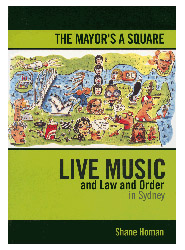| |
 This is indeed a wonderful volume. Based on a PhD thesis, Shane Homan's monograph on live music in Sydney, Australia, is very well written, carefully designed and abundant with details from the past live popular music in the town. He tells a plenty of stories of his informants, intertwined and knitted together in a small epic of the town. For quite a while I did not read so reach academic writing.
At the first sight the volume does not look thin. However, its narration is so compressed that it does not allow any kind of superficial or instant reading. Although his initial intention was to present a history of rock music in the town, Shane Homan did not hesitate to go back to history. He did intensive archive studies, so we can understand many details which would otherwise be incomprehensible. Very detailed descriptions of past times efficiently prove the importance of historical perspective in understanding of present-day popular music (and popular culture in general). Too many times, the ethnographic approach has become an excuse for not using historical sources. No wonder if “cultural studies” (and anthropology, for that matter) are seemingly in permanent crisis!
Another very important part of Shane Homan’s work is use of legislation sources. It is difficult to imagine how profoundly the local (as well as regional and national) legislation affects the daily life. It is not only a manifestation of changing political relations and their output that deserve our attention. Legislation is at the same time based on expressed needs of involved people and derived from controversial development of something we may describe as a public. It appears so transparent in permanent struggle for place to socialise, to enjoy or just to hang-out!
Shane Homan’s writing is theoretically very well-grounded. In the first chapter he discusses popular music through ritual and performance as public acts and politics that affect daily life. His point of departure is tradition of Birmingham’s school, but later on he follows Foucault’s governmentality lead.
For him the ‘live music venue plays an important social function, accommodating a plurality of communities and identities’ and he sees the ‘rock pub as a site of social exchange that is often more valuable than its economic forms’ (13). Although he stresses the importance of economic factors of culture industry, he observes governmentality through laws and legislation. However, in doing so, he never loses from his sight the destinies of individual visitors and musicians who used venues to make something from their daily life.
After very reach description of the history of live music playing in Sydney since the beginning of the century, he describes the situation in the mid-fifties when rock’n’roll found its way to music venues in Sydney. Shane Homan describes the development and problems in the development of the local acts through “circuits” (boy’s clubs, hotel…) where it was possible to play rock’n’roll. He puts special attention to initial exclusion of women from the pubs and similar venues in the late 1950s, discusses noise and music playing as work.
Then he presents in many details – indeed a thick description – the swinging 1960s as a ‘clubland’. In the 1970s Australian rock moved into the suburbs. It was a time of gender emancipation as well. Shane Homan has very efficiently documented these and similar “grassroots” social struggles which occasionally got dramatic extensions. Punk and metal era brought new challenges to the sites of live music in Sydney. Local issues were becoming global and vice versa. Alcohol became another contested issue, as well as residents’ responses and actions against noise and strange habits. The most problematic remains the opposition between public interests and private rights.
Approaching the 1990s, the narration becomes more and more first-handed. Interestingly, the issue of discussion again comes back to moral panic – now concerning use of new drugs and clubbing. Nothing new on Earth? If anyone thinks that the times of social struggles are over, he or she should read the story of so seemingly unproblematic issue as live music venues. It is a contested terrain, it has been such in the past and it will most likely remain so.
Shane Homan’s volume gives us many new insights into the functioning of the popular music scene – or scenes – in a particular urban locality. I sincerely hope that the book will receive a world-wide distribution, because it surely deserves it.
|
|

